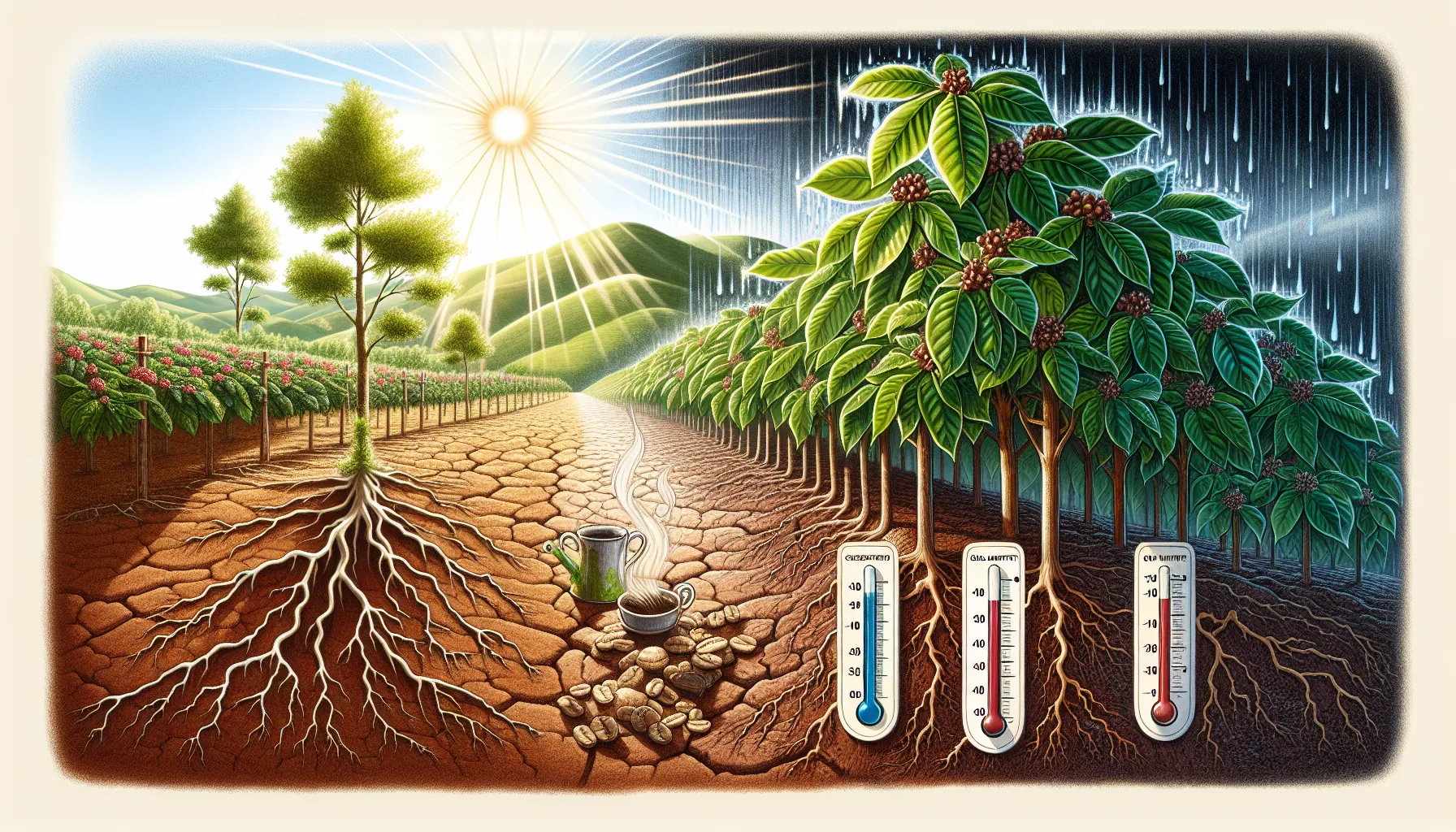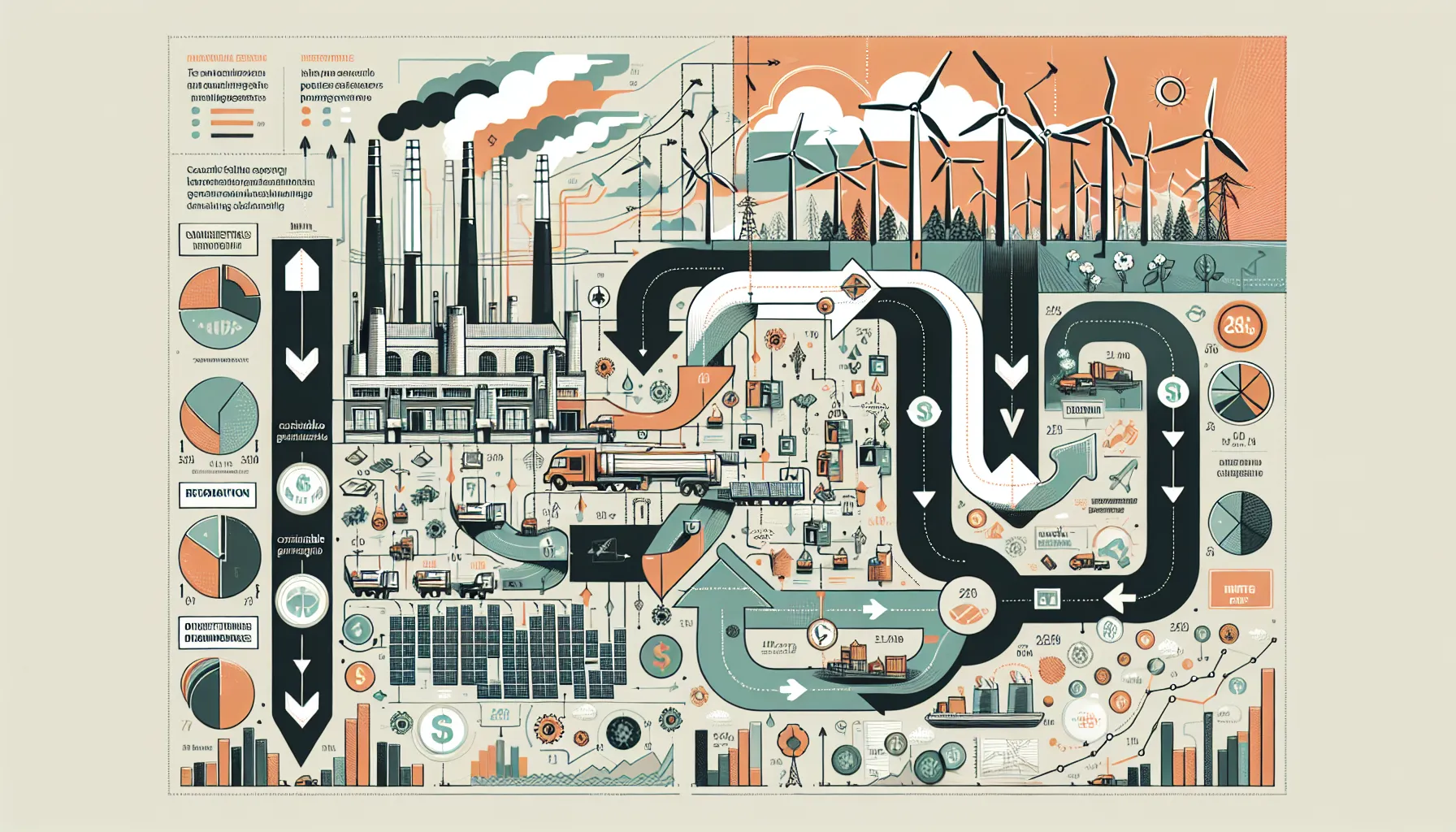Welcome to our IELTS Reading practice session focusing on the impact of climate change on coffee production. As an experienced IELTS instructor, I’ve designed this comprehensive practice test to help you improve your reading skills while exploring this crucial environmental topic. Let’s dive into the passages and questions that mirror the actual IELTS exam structure.
Nội dung bài viết
 Climate change affecting coffee plants
Climate change affecting coffee plants
Passage 1 (Easy Text)
The Global Coffee Industry
Coffee is one of the world’s most popular beverages, with millions of people starting their day with a steaming cup. The global coffee industry is a significant economic force, providing livelihoods for farmers in over 50 countries. However, this industry is facing a growing threat from climate change, which is altering the delicate balance of conditions needed for coffee cultivation.
Coffee plants, particularly the widely grown Arabica variety, thrive in specific environmental conditions. They require a stable climate with temperatures between 15°C and 25°C, adequate rainfall, and rich, well-draining soil. These conditions are typically found in tropical and subtropical regions, often in mountainous areas known as the “Bean Belt” that circles the globe.
Climate change is disrupting these ideal growing conditions. Rising temperatures, changing rainfall patterns, and more frequent extreme weather events are all impacting coffee production. As temperatures increase, suitable areas for coffee cultivation are shifting to higher altitudes, where land may be limited or less accessible.
Additionally, warmer temperatures are creating favorable conditions for pests and diseases that affect coffee plants. The coffee berry borer, a tiny beetle that is a major coffee pest, is now able to survive and reproduce at higher altitudes due to warmer temperatures. Similarly, coffee leaf rust, a fungal disease, has become more prevalent in many coffee-growing regions.
These challenges are not just environmental; they have significant economic and social implications. Many smallholder farmers in developing countries depend on coffee for their income. As climate change affects crop yields and quality, it threatens the livelihoods of millions of people and the economic stability of coffee-producing regions.
In response to these challenges, the coffee industry is exploring various adaptation strategies. These include developing more resilient coffee varieties, implementing improved farming practices, and supporting farmers in diversifying their crops. Some companies are also investing in research to better understand and mitigate the impacts of climate change on coffee production.
Consumers can also play a role in supporting sustainable coffee production. By choosing coffee from brands that prioritize environmental sustainability and fair trade practices, consumers can help support farmers and encourage more climate-resilient coffee production methods.
Questions 1-7
Do the following statements agree with the information given in the Reading Passage?
Write
TRUE if the statement agrees with the information
FALSE if the statement contradicts the information
NOT GIVEN if there is no information on this
- Coffee is consumed by millions of people worldwide.
- Arabica coffee can grow in any climate condition.
- The “Bean Belt” refers to mountainous areas where coffee is typically grown.
- Climate change is causing coffee cultivation to move to lower altitudes.
- The coffee berry borer is benefiting from warmer temperatures.
- Climate change only affects the environmental aspects of coffee production.
- Some coffee companies are researching ways to address climate change impacts.
Questions 8-13
Complete the sentences below.
Choose NO MORE THAN TWO WORDS from the passage for each answer.
- Coffee plants require ___ soil that drains well for optimal growth.
- The coffee berry borer is described as a ___ that poses a significant threat to coffee crops.
- ___ is a fungal disease affecting coffee plants that has become more common due to climate change.
- Many ___ in developing countries rely on coffee cultivation for their income.
- The coffee industry is developing more ___ varieties of coffee plants to adapt to changing conditions.
- Consumers can support sustainable coffee production by choosing brands that prioritize ___ and fair trade practices.
Passage 2 (Medium Text)
Climate Change and Coffee: A Complex Relationship
The intricate relationship between climate change and coffee production is a subject of growing concern for scientists, farmers, and coffee enthusiasts alike. As global temperatures rise and weather patterns become increasingly unpredictable, the coffee industry faces unprecedented challenges that threaten not only the quantity but also the quality of coffee produced worldwide.
Coffee, particularly the high-quality Arabica variety, is notoriously sensitive to environmental conditions. It requires a delicate balance of temperature, rainfall, and soil conditions to thrive. Historically, these conditions were found in specific regions around the world, creating what is known as the Coffee Belt – a band around the Earth near the Equator where coffee has traditionally been cultivated.
However, climate change is altering this established geography of coffee production. Rising temperatures are causing the suitable areas for coffee cultivation to shift upwards in elevation and towards the poles. This shift is not merely a matter of relocating farms; it involves complex changes in local ecosystems, soil compositions, and even cultural practices tied to coffee farming.
One of the most immediate impacts of climate change on coffee production is the increased prevalence of pests and diseases. Warmer temperatures and altered rainfall patterns create more favorable conditions for coffee’s natural enemies. The coffee berry borer, for instance, is now found at higher altitudes where it was previously too cold for them to survive. Similarly, coffee leaf rust, a devastating fungal disease, has become more widespread and severe in many coffee-growing regions.
Climate change also affects the phenology – the timing of natural events – of coffee plants. Changes in temperature and rainfall can disrupt the delicate timing of coffee flowering and fruit development. Unpredictable weather patterns can lead to unsynchronized flowering or rapid ripening, which affects both yield and quality. In some cases, entire harvests can be lost due to unexpected frosts or prolonged dry spells.
The impact of climate change on coffee quality is particularly concerning. Coffee’s flavor profile is intricately linked to its growing conditions. Subtle changes in temperature, sunlight exposure, and rainfall can significantly alter the chemical composition of coffee beans, affecting their taste, aroma, and overall quality. Some studies suggest that climate change could lead to a general decline in coffee quality, potentially altering the gourmet coffee market.
In response to these challenges, the coffee industry is exploring various adaptation strategies. These range from developing more climate-resilient coffee varieties to implementing advanced agricultural practices. Agroforestry – the practice of growing coffee under a canopy of shade trees – is gaining popularity as a way to mitigate some effects of climate change. This method not only provides shade and temperature regulation for coffee plants but also contributes to biodiversity and carbon sequestration.
Another approach involves diversification, both in terms of coffee varieties and alternative crops. Some farmers are experimenting with different coffee species, such as Robusta, which is generally more heat-tolerant than Arabica. Others are incorporating other crops into their farms to spread risk and provide alternative income sources.
Technology is also playing a crucial role in adaptation efforts. Advanced weather monitoring systems, precision agriculture techniques, and genetic research are all being employed to help coffee farmers adapt to changing conditions. Some companies are even exploring indoor cultivation methods, although these remain limited in scale and economic viability.
The challenges posed by climate change to coffee production are not just environmental; they have significant socio-economic implications. Many coffee-growing regions are in developing countries, where smallholder farmers depend on coffee for their livelihoods. Changes in coffee production can therefore have profound effects on local economies and communities.
As the coffee industry grapples with these challenges, there is a growing recognition of the need for collaborative, industry-wide efforts. This includes not only farmers and coffee companies but also governments, research institutions, and consumers. Sustainable sourcing practices, fair trade initiatives, and consumer education are all part of a broader strategy to create a more resilient and sustainable coffee industry in the face of climate change.
Questions 14-19
Choose the correct letter, A, B, C, or D.
-
According to the passage, which of the following is true about Arabica coffee?
A) It can adapt easily to different climates
B) It is less sensitive to environmental changes than other coffee varieties
C) It requires specific environmental conditions to grow well
D) It is no longer cultivated in the Coffee Belt -
The impact of climate change on coffee production includes:
A) A shift in suitable growing areas to lower elevations
B) An increase in the prevalence of pests and diseases
C) A decrease in the global demand for coffee
D) An improvement in the overall quality of coffee -
How does climate change affect the phenology of coffee plants?
A) It makes the plants grow faster
B) It causes the plants to produce more beans
C) It disrupts the timing of flowering and fruit development
D) It extends the lifespan of coffee plants -
What is mentioned as a potential consequence of climate change on coffee quality?
A) Improved flavor profiles
B) Increased variety in taste
C) Higher caffeine content
D) Alterations in chemical composition affecting taste and aroma -
Agroforestry in coffee production:
A) Is a new technique developed specifically for climate change adaptation
B) Involves growing coffee plants indoors
C) Helps regulate temperature and contributes to biodiversity
D) Is not effective in mitigating climate change effects -
The passage suggests that the challenges of climate change on coffee production:
A) Only affect large-scale coffee producers
B) Have minimal impact on developing countries
C) Can be easily solved with current technology
D) Have significant socio-economic implications beyond environmental concerns
Questions 20-26
Complete the summary below.
Choose NO MORE THAN TWO WORDS from the passage for each answer.
Climate change is significantly impacting coffee production worldwide. The traditional (20) where coffee is grown is shifting due to rising temperatures. This shift affects not only the location of farms but also local (21) and cultural practices. Climate change is also increasing the prevalence of pests and diseases, such as the coffee berry borer and coffee (22) ___.
The (23) of coffee plants is being disrupted, affecting flowering and fruit development. These changes can lead to losses in both yield and quality. In response, the industry is exploring various (24) strategies, including the development of more resilient coffee varieties and the implementation of advanced agricultural practices like (25) ___.
Technology is playing a crucial role in these efforts, with some companies even exploring (26) ___ methods for coffee cultivation. However, the challenges extend beyond environmental concerns, affecting the livelihoods of smallholder farmers and local economies in many developing countries.
Passage 3 (Hard Text)
The Multifaceted Impact of Climate Change on Global Coffee Production
The intricate relationship between climate change and coffee production represents a microcosm of the broader challenges facing global agriculture in the 21st century. Coffee, as one of the world’s most traded commodities and a crop of immense cultural and economic significance, serves as a compelling case study for understanding the complex interplay between changing climatic conditions and agricultural systems.
The coffee plant, particularly the highly prized Arabica variety, is notably sensitive to environmental fluctuations. It thrives within a narrow range of climatic conditions, requiring temperatures between 15°C and 25°C, annual rainfall of 1500-2000mm, and specific soil compositions. These exacting requirements have historically confined coffee cultivation to the “Bean Belt,” a equatorial band encompassing parts of Latin America, Africa, and Asia. However, anthropogenic climate change is rapidly altering this established geography of production.
Recent climatological models project significant shifts in the suitability of current coffee-growing regions. By 2050, it is estimated that the area suitable for coffee production could decrease by up to 50% under some climate scenarios. This reduction is not uniform across all coffee-growing regions; while some areas may become completely unsuitable, others may experience enhanced growing conditions. For instance, higher-altitude regions previously too cold for coffee cultivation may become viable, while traditional lower-altitude growing areas may become too warm.
These shifts in suitable growing areas present a myriad of challenges. The relocation of coffee farms is not simply a matter of moving plants; it involves complex changes in land use, local ecosystems, and socio-economic structures. Many coffee farmers, particularly smallholders in developing countries, lack the resources or knowledge to adapt to these changing conditions. Furthermore, the loss of traditional coffee-growing areas could have profound implications for local biodiversity, as many of these regions are hotspots of biological diversity.
Climate change is also exacerbating the prevalence and severity of pests and diseases affecting coffee plants. The coffee berry borer (Hypothenemus hampei), considered the most damaging pest in coffee production, is expanding its range due to warming temperatures. Similarly, coffee leaf rust (Hemileia vastatrix), a fungal pathogen, has caused devastating outbreaks in recent years, linked to changing climate patterns. These biological stressors not only reduce yields but also increase the economic pressure on farmers, often leading to increased use of pesticides and fungicides, which can have further environmental impacts.
The effects of climate change on coffee quality are particularly nuanced and potentially far-reaching. Coffee’s organoleptic properties – its taste, aroma, and mouthfeel – are the result of complex biochemical processes influenced by environmental conditions during growth and maturation. Changes in temperature and precipitation patterns can alter these processes, potentially leading to changes in the flavor profile of coffee from specific regions. Some studies suggest that climate change could lead to a homogenization of coffee flavors, threatening the diverse terroir-based characteristics that are highly valued in the specialty coffee market.
In response to these challenges, the coffee industry is pursuing a range of adaptation and mitigation strategies. At the farm level, this includes the implementation of climate-smart agricultural practices such as agroforestry, improved water management, and soil conservation techniques. These practices not only help to buffer coffee plants against climatic extremes but also contribute to carbon sequestration and biodiversity conservation.
Genetic research is another crucial area of focus. Scientists are working to develop more climate-resilient coffee varieties that can withstand higher temperatures, drought, and increased pest pressure. This includes both traditional breeding programs and more controversial genetic modification approaches. Some researchers are also exploring the potential of other coffee species, such as Coffea stenophylla, which may be more adaptable to future climate conditions.
The coffee industry is also increasingly recognizing the need for landscape-level approaches to climate resilience. This involves considering coffee farms as part of broader ecosystems and watersheds, and implementing management practices that enhance the overall resilience of these systems. Such approaches often require collaboration between multiple stakeholders, including farmers, local communities, government agencies, and conservation organizations.
Technology is playing an increasingly important role in climate adaptation efforts. Precision agriculture techniques, including the use of remote sensing and big data analytics, are helping farmers to optimize resource use and respond more effectively to changing conditions. Some companies are even exploring controlled environment agriculture for coffee production, although the economic viability and scalability of such approaches remain to be seen.
The socio-economic implications of climate change on coffee production are profound and multifaceted. Coffee is a primary source of income for millions of smallholder farmers in developing countries. Changes in production patterns could lead to significant economic dislocations, potentially exacerbating rural poverty and driving urbanization. There are also concerns about the impact on global coffee prices and supply stability, which could have ripple effects throughout the global economy.
Furthermore, coffee production is deeply intertwined with cultural identities and traditional ways of life in many regions. The potential loss of coffee-growing areas could therefore have significant cultural impacts, threatening traditional knowledge systems and local heritage.
As the coffee industry grapples with these complex challenges, there is growing recognition of the need for collaborative, systemic approaches. This includes not only technical solutions but also policy interventions, market-based mechanisms, and consumer education. Initiatives such as carbon insetting, where companies invest in emissions reduction projects within their own supply chains, are gaining traction as ways to simultaneously address climate mitigation and adaptation.
The future of coffee in a changing climate remains uncertain, but it is clear that maintaining the viability and sustainability of coffee production will require unprecedented levels of innovation, collaboration, and adaptation across the entire value chain. As such, the coffee sector’s response to climate change may offer valuable lessons for other agricultural systems facing similar challenges in the coming decades.
Questions 27-32
Choose the correct letter, A, B, C, or D.
-
According to the passage, by 2050, the area suitable for coffee production could:
A) Increase by 50%
B) Decrease by up to 50% in some scenarios
C) Remain largely unchanged
D) Shift entirely to higher altitudes -
The relocation of coffee farms due to climate change is challenging because:
A) Coffee plants cannot survive transplantation
B) It only affects large-scale farmers
C) It involves complex changes in land use and socio-economic structures
D) New areas lack the necessary soil composition for coffee growth -
The coffee berry borer is:
A) A fungal disease affecting coffee plants
B) A pest that is reducing its range due to climate change
C) The most damaging pest in coffee production
D) A new species that has emerged due to warming temperatures -
According to the passage, climate change could affect coffee quality by:
A) Improving the flavor profile of all coffee varieties
B) Increasing the caffeine content in coffee beans
C) Potentially leading to a homogenization of coffee flavors
D) Enhancing the terroir-based characteristics of coffee -
Which of the following is NOT mentioned as a climate adaptation strategy for the coffee industry?
A) Implementing agroforestry practices
B) Developing climate-resilient coffee varieties
C) Exploring controlled environment agriculture
D) Completely shifting to indoor coffee production -
The passage suggests that the socio-economic implications of climate change on coffee production include:


